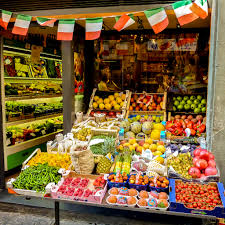Italy 2018 – The World’s Healthiest Nation
Twelve “Magical” Foods that help Make
Italy the World’s healthiest Nation
The Italian Diet
*
Despite a struggling economy, Italy in 2018 has again been ranked the World’s Healthiest Nation. The country topped the Bloomberg Global Health index, placing 1st out of 163 countries.
A baby born in Italy can expect to live to at least 80, with the country also containing a ‘blue zone’ in the Barbagia region of Sardinia. In these highlands, there are 10 times as many centurians as in America.
*
Italy The World’s Healthiest Nation
*
Italy is home to some of the best cuisine in the world. Food is deeply embedded into their culture and the classic Italian diet encompasses plenty of vegetables, olive oil, pasta, lean meats and fresh fish.
This resulted in Italians having lower blood pressure and cholesterol than other developed nations.
Mediterranean diets are considered one of the healthiest and sustainable to follow so it’s no surprise that this is why Italy have scored so highly.
For the health benefits of the Italian Diet Click below
www.medicalnewstoday.com/articles/283828.php
*
#12 – Lemons
For the health benefits of Lemons in your diet, Click below
http://www.medicalnewstoday.com/articles/283476.php
*
#11 – Pepperoncini – (Hot Chili Peppers)
The pepperoncino probably came to Italy in the early 16th century, after Columbus had taken samples from the New World to Europe in 1492. Like the tomato, the peperoncino was first considered a decorative and possibly poisonous plant before it was adopted into Italian cuisine.
The peperoncino is especially important in Calabrian cuisine. In late summer, peperoncini are stitched on wires and hung from buildings there. They are left to dry in spots with sunlight and ventilation to conserve them, allowing their use in cooking until the next harvest. They are eaten whole, fried until crisp, crushed, powdered or as a paste.
Notable Calabrian dishes which use peperoncini are the condiment Bomba Calabrese and the spreadable pork sausage ‘Nduja. It is also used in dishes of other regional cuisines of Southern and Central Italy, such as the Roman Arrabbiata sauce.
Since 1992 the annual Peperoncino Festival is held in the town of Diamante in Calabria. Organized by the Accademia Italiana del Peperoncino, the festival now attracts tens of thousands of visitors. It is held for four days surrounding the first weekend of September on the town’s seaside promenade. The festival has a large market where local food products made with peperoncini are sold and hosts a peperoncino-eating contest.
For the health benefits of Pepperoncini in your diet, Click below
www.medicalnewstoday.com/articles/280569.php
*
#10 – Chick peas – Garbanzo Beans – Ci Ci Beans
Ancient people also associated chickpeas with Venus because they were said to offer medical uses such as increasing sperm and milk, provoking menstruation and urine and helping to treat kidney stones.
By the Bronze Age, chickpeas were known in Italy and Greece. In classical Greece, they were called erébinthos and eaten as a staple, a dessert, or consumed raw when young. The Romans knew several varieties such as venus, ram, and punic chickpeas. They were cooked down into a broth or roasted as a snack. Carbonized chickpeas have been found at the Roman legion fort at Neuss, Germany in layers from the first century CE, along with rice.
For the health benefits of including Chick Peas in your diet, Click below
www.medicalnewstoday.com/articles/280244.php
*
#9 – Garlic
Garlic is an invaluable herb with a ton of health benefits for you to take advantage of. It has a solid nutritional profile as well, even though you are unlikely to eat a large portion at any one time. Try to include small amounts in as many foods as you can. Often we cook with it and then remove the actual clove before serving.
Garlic was used as an antiseptic to prevent gangrene during World War I and World War II.
For the health benefits of including Garlic in your diet, Click below
www.medicalnewstoday.com/articles/269143.php
#8 – Tomatoes
Up until the end of the eighteenth century, physicians warned against eating tomatoes, fearing they caused not only appendicitis but also stomach cancer from tomato skins adhering to the lining of the stomach.
Colonel Robert Gibbon Johnson of Salem, New Jersey had brought the tomato home from abroad in 1808. He had been offering a prize yearly for the largest fruit grown, but the general public considered the tomato an ornamental plant rather than one for food.
As the story is told, it was Colonel Johnson who on September 26, 1820 once and for all proved tomatoes non-poisonous and safe for consumption. He stood on the steps of the Salem courthouse and bravely consumed an entire basket of tomatoes without keeling over or suffering any ill effects whatsoever. His grandstanding attracted a crowd over over 2,000 people who were certain he was committing public suicide. The local firemen’s band even played a mournful dirge to add to the perceived morbid display of courage.
Johnson’s public stunt garnered a lot of attention, and North America’s love affair with the tomato was off and running.
By 1842, farm journals of the time were touting the tomato as the latest craze and those who eschewed it as “objects of pity.”
For the health benefits of including Tomatoes in your diet, Click below
www.medicalnewstoday.com/articles/273031.php
*
#7 – Onions
In 1919 when the flu killed 40 million people there was this Doctor that visited the many farmers to see if he could help them combat the flu. Many of the farmers and their family had contracted it and many died.
The doctor came upon this one farmer and to his surprise, everyone was very healthy. When the doctor asked what the farmer was doing that was different the wife replied that she had placed an unpeeled onion in a dish in the rooms of the home, (probably only two rooms back then). The doctor couldn’t believe it and asked if he could have one of the onions and placed it under the microscope. She gave him one and when he did this, he did find the flu virus in the onion. It obviously absorbed the virus, therefore, keeping the family healthy.
The moral of the story is, buy some onions and place them in bowls around your home. If you work at a desk, place one or two in your office or under your desk or even on top somewhere. Try it and see what happens. We did it last year and we never got the flu.
For the health benefits of including Onions in your diet, Click below
www.medicalnewstoday.com/articles/276714.php
#6 – Fresh Fruit
Speaks for itself
For the health benefits of including Fruit in your diet, Click below
www.medicalnewstoday.com/articles/281903.php
*
#4 – Fresh Greens
(Dandelions, Beet Greens, Broccoli, Rapini, Arugula, Spinach, Basil, Endive, Escarole, Romaine, Radicchio, Lettuce, etcetera)
For the health benefits of including Fresh Greens in your diet, Click below
Cookingreens.com/health-benefits-of-darkleafy-greens/
*
#3 – Vino
Health Benefits of Wine
Studies of the health effects of wine have focused on cardiovascular health, cancer, Alzheimer’s disease, alcoholism, cirrhosis of the liver, and oral bacteria. Although excessive alcohol consumption has adverse health effects, epidemiological studies have consistently demonstrated that moderate consumption of alcohol and wine is statistically associated with a decrease in cardiovascular illness such as heart failure.
A 2007 study found that both red and white wines are effective antibacterial agents against strains of Streptococcus. In addition, a report in the October 2008 issue of Cancer Epidemiology, Biomarkers and Prevention posits that moderate consumption of red wine may decrease the risk of lung cancer in men.
Wine’s effect on the brain is also under study. One study concluded that wine made from the Cabernet Sauvignon grape reduces the risk of Alzheimer’s Disease. Another study found that among alcoholics, wine damages the hippocampus, a brain area involved in memory processes, to a greater degree than other alcoholic beverages.
Video on the Health benefits of Wine – click below
www.medicalnewstoday.com/articles/287388.php
#2 – Vinegar
According to legend, in France during the Black Plague, four thieves were able to rob houses of plague victims without being infected themselves. When finally caught, the judge offered to grant the men their freedom, on the condition that they revealed how they managed to stay healthy. They claimed that a medicine woman sold them a potion made of garlic soaked in soured red wine (vinegar). Variants of the recipe, called Four Thieves Vinegar, have been passed down for hundreds of years and are a staple of New Orleans hoodoo practices.
Video on the health benefits of Vinegar click below
www.dailymail.co.uk/health/article-37317/The-healing-powers-vinegar.html
*
#1 – Olive Oil
The olive tree shows tremendous longevity and resilience: even through the harshest summers and winters it continues to grow strong and bear fruit. For this reason, olive oil was believed to bestow strength and youth to those who consumed it.
In fact, early Middle Eastern civilizations relied on olive oil to cure everything, and to this day many continue to drink it daily to keep the body healthy.
For the Video on the health benefits of Olive Oil click below
What are the health benefits of Olive Oil
www.MedicalNewsToday.com/articles/266258.php
This site contains product affiliate links. We may receive a commission if you make a purchase after clicking on one of these links.


